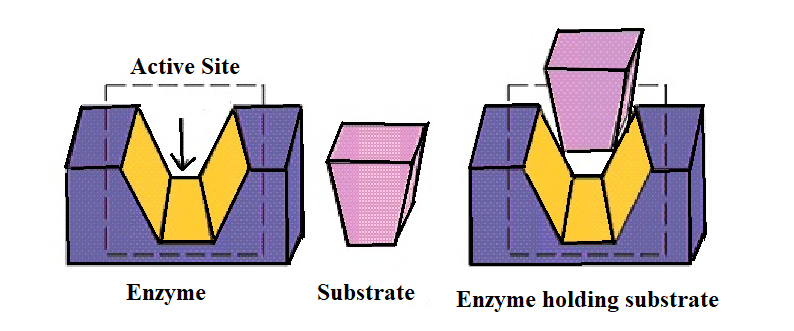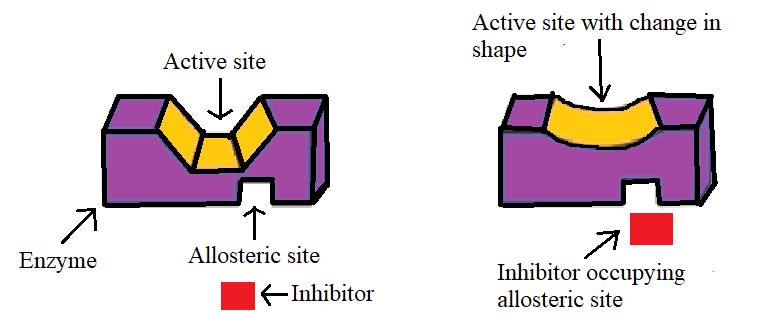
Which site of an enzyme is called an allosteric site?
A) Which binds to the cell wall
B) Where drugs bind to an enzyme
C) Which is not the active site, where some drugs bind to an enzyme
D) None of these
Answer
133.8k+ views
Hint: the drug binds with the enzyme. The substrate and the drug which are also known as inhibitors have an affinity to bind to the active site present on the enzyme. In the non –competitive inhibition the drug does not bind at the active site. But it binds to the allosteric site. This changes the shape and conformation of the enzyme and reduces the affinity of the substrate towards the enzyme.
Complete step by step answer:
Drugs interact with the macromolecules such as carbohydrates, proteins, lipids, and nucleic acid. These macromolecules are known to perform different functions in the body. The enzymes carry out various functions in the body.
The main role of the drugs is to either increase or decrease the role of enzyme-catalyzed reactions. The inhibition of enzymes is a common role in drug action. Many drugs show their effect by modifying the function of enzymes. The enzyme inhibitors can block the binding site and prevent the binding of the substrate or can inhibit the catalytic activity of the enzyme.
The drug inhibits the attachment of the substrate on the active site of the enzyme in the following two ways:
(I)Competitive inhibition:
The substrate and inhibitor cannot bind to the enzyme at the same time. This usually results from the inhibitor having an affinity for the active site of the enzyme where the substrate also binds. Therefore, the substrate and the inhibitor compete for the approach to the enzyme’s active site. Such drugs are called competitive inhibitors.

(II)Non-Competitive inhibition:
In non-competitive inhibition drugs, do not bind to the active site but bind to the different sites of the enzyme called the allosteric site. This binding of the inhibitor allosteric site changes the shape and conformation of the active site so that the affinity of the substrate for the active site is reduced.
It may be noted that if the bond formed between the enzyme and the inhibitor is a strong covalent bond, therefore, cannot be broken easily then the enzymes get blocked permanently. The body then degrades the enzyme-inhibitor complex and synthesis of new enzymes.

Thus from the non-competitive inhibition of drugs across the enzyme we get that allosteric sites are not active but the drug binds to this inactive site. This results in the binding of the drug to the enzyme.
Hence, (C) is the correct option.
Additional information:
The two important main functions of the enzymes are:
1) The first function of the enzyme is to hold the substrate for a chemical reaction. The substrate is held in the active site of the enzyme in such a position that it can be readily and effectively attacked by the reagent which can be a drug.
2) The second main function of the enzyme is to provide the functional group which will attack the substrate and carry out the chemical reaction.
Note:(1) The protein which performs the role of the biological catalyst in the biological system is called the enzyme.
(2) The enzyme acts on the lock and key principle.
(3)there is one more drug enzyme attachment which is uncompetitive inhibition.
Complete step by step answer:
Drugs interact with the macromolecules such as carbohydrates, proteins, lipids, and nucleic acid. These macromolecules are known to perform different functions in the body. The enzymes carry out various functions in the body.
The main role of the drugs is to either increase or decrease the role of enzyme-catalyzed reactions. The inhibition of enzymes is a common role in drug action. Many drugs show their effect by modifying the function of enzymes. The enzyme inhibitors can block the binding site and prevent the binding of the substrate or can inhibit the catalytic activity of the enzyme.
The drug inhibits the attachment of the substrate on the active site of the enzyme in the following two ways:
(I)Competitive inhibition:
The substrate and inhibitor cannot bind to the enzyme at the same time. This usually results from the inhibitor having an affinity for the active site of the enzyme where the substrate also binds. Therefore, the substrate and the inhibitor compete for the approach to the enzyme’s active site. Such drugs are called competitive inhibitors.

(II)Non-Competitive inhibition:
In non-competitive inhibition drugs, do not bind to the active site but bind to the different sites of the enzyme called the allosteric site. This binding of the inhibitor allosteric site changes the shape and conformation of the active site so that the affinity of the substrate for the active site is reduced.
It may be noted that if the bond formed between the enzyme and the inhibitor is a strong covalent bond, therefore, cannot be broken easily then the enzymes get blocked permanently. The body then degrades the enzyme-inhibitor complex and synthesis of new enzymes.

Thus from the non-competitive inhibition of drugs across the enzyme we get that allosteric sites are not active but the drug binds to this inactive site. This results in the binding of the drug to the enzyme.
Hence, (C) is the correct option.
Additional information:
The two important main functions of the enzymes are:
1) The first function of the enzyme is to hold the substrate for a chemical reaction. The substrate is held in the active site of the enzyme in such a position that it can be readily and effectively attacked by the reagent which can be a drug.
2) The second main function of the enzyme is to provide the functional group which will attack the substrate and carry out the chemical reaction.
Note:(1) The protein which performs the role of the biological catalyst in the biological system is called the enzyme.
(2) The enzyme acts on the lock and key principle.
(3)there is one more drug enzyme attachment which is uncompetitive inhibition.
Recently Updated Pages
JEE Main 2025 Session 2 Form Correction (Closed) – What Can Be Edited

Sign up for JEE Main 2025 Live Classes - Vedantu

JEE Main Books 2023-24: Best JEE Main Books for Physics, Chemistry and Maths

JEE Main 2023 April 13 Shift 1 Question Paper with Answer Key

JEE Main 2023 April 11 Shift 2 Question Paper with Answer Key

JEE Main 2023 April 10 Shift 2 Question Paper with Answer Key

Trending doubts
JEE Main 2025 Session 2: Application Form (Out), Exam Dates (Released), Eligibility, & More

JEE Main 2025: Conversion of Galvanometer Into Ammeter And Voltmeter in Physics

JEE Main 2025: Derivation of Equation of Trajectory in Physics

Electric Field Due to Uniformly Charged Ring for JEE Main 2025 - Formula and Derivation

Classification of Drugs

Chlorobenzene can be prepared by reacting aniline with class 12 chemistry JEE_Main

Other Pages
NCERT Solutions for Class 12 Chemistry Chapter 6 Haloalkanes and Haloarenes

NCERT Solutions for Class 12 Chemistry Chapter 2 Electrochemistry

NCERT Solutions for Class 12 Chemistry Chapter 7 Alcohol Phenol and Ether

NCERT Solutions for Class 12 Chemistry Chapter 1 Solutions

Solutions Class 12 Notes: CBSE Chemistry Chapter 1

Electrochemistry Class 12 Notes: CBSE Chemistry Chapter 2




